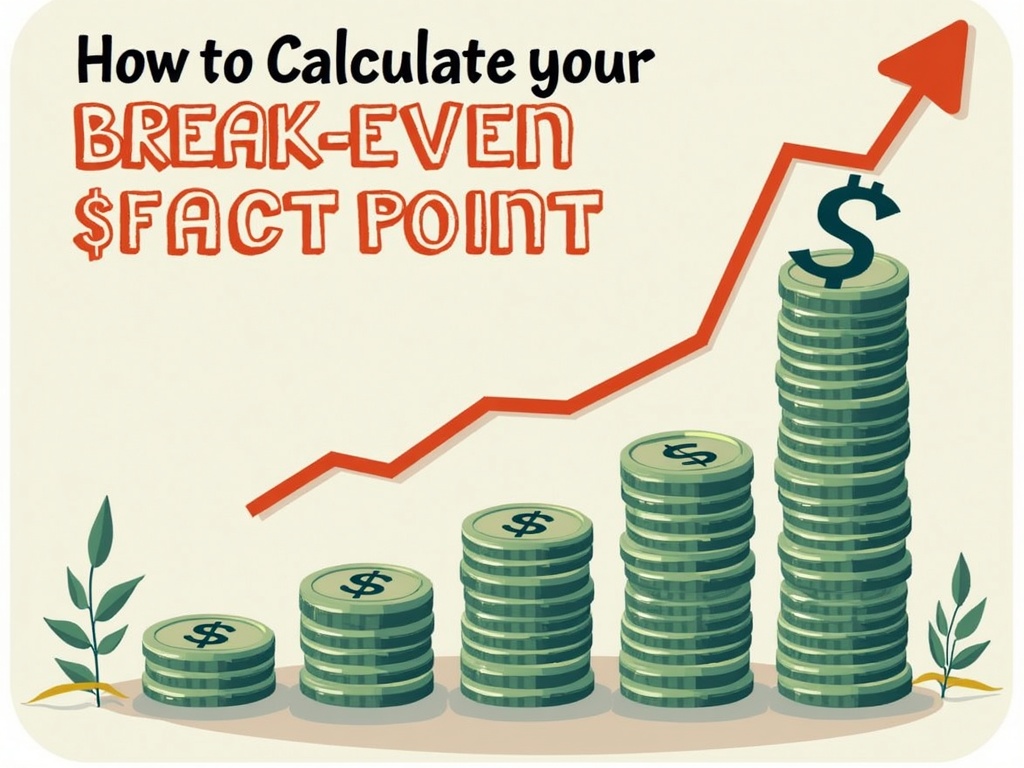How to Calculate Your Break-Even Point: A Comprehensive Guide
Imagine standing at the edge of a cliff, ready to launch your dream business. You’ve poured your heart, soul, and savings into this venture. But before you take that leap, wouldn’t you want to know how far you need to fly before you can land safely on solid ground? That, in essence, is what calculating your break-even point is all about. It’s your financial safety net, the point where your business stops bleeding money and starts to sustain itself. Let’s dive into understanding this crucial metric and how you can calculate it with confidence.
Why Calculating Your Break-Even Point is Crucial
Understanding your break-even point is more than just a number; it’s a cornerstone of sound financial planning. It’s the moment your revenue equals your total costs, where you’re neither making a profit nor incurring a loss. This knowledge empowers you in several key ways:
- Pricing Strategies: Knowing your break-even point allows you to set realistic and profitable prices for your products or services. You can avoid underpricing, which leads to losses, and overpricing, which deters customers.
- Financial Forecasting: It helps you create realistic financial projections. Investors often demand to see a break-even analysis to gauge the viability of your business plan. It shows them a clear path to profitability.
- Cost Management: Identifying your break-even point pushes you to analyze your costs meticulously. You can identify areas where you can trim expenses, improve efficiency, and boost your bottom line.
- Decision Making: Whether you’re considering expanding your business, launching a new product, or taking out a loan, understanding your break-even point provides a solid financial foundation for making informed decisions.
- Risk Assessment: It allows you to assess the risk associated with your business. A lower break-even point indicates a more resilient business model, capable of weathering economic downturns or unexpected expenses.
Understanding the Components of the Break-Even Point
Before you can calculate your break-even point, you need to understand the components involved. These fall into two primary categories: fixed costs and variable costs.
Fixed Costs
Fixed costs are expenses that remain consistent regardless of your sales volume. These are the costs you must pay even if you don’t sell a single product or service. Examples include:
- Rent: Your monthly payment for your office or storefront.
- Salaries: The wages you pay to your employees (not including commissions).
- Insurance: Premiums for business liability, property, or health insurance.
- Depreciation: The gradual decline in value of assets like equipment or vehicles.
- Utilities: Basic services like electricity, water, and internet.
It’s important to note that fixed costs are *fixedwithin a certain range of production or sales. If you significantly scale up your operations, you might need to rent a larger space or hire more staff, which would increase your fixed costs.
Variable Costs
Variable costs, on the other hand, fluctuate directly with your sales volume. The more you produce and sell, the higher your variable costs will be. Examples include:
- Direct Materials: The raw materials that go into your products.
- Direct Labor: The wages you pay to employees directly involved in production (e.g., assembly line workers).
- Sales Commissions: Payments to sales staff based on their sales performance.
- Shipping Costs: The expenses associated with delivering your products to customers.
- Credit Card Processing Fees: The fees charged by payment processors for each transaction.
Identifying and accurately tracking both your fixed and variable costs is essential for a realistic break-even analysis. Without this data, your calculations will be inaccurate, and your business decisions may be misguided.
Calculating the Break-Even Point: Two Key Formulas
There are two primary ways to calculate your break-even point: in units and in sales revenue.
Break-Even Point in Units
This calculation tells you how many units of your product or service you need to sell to cover all your costs. The formula is:
**Break-Even Point (Units) = Fixed Costs / (Sales Price Per Unit – Variable Cost Per Unit)**
Let’s break this down with an example:
Imagine you run a small bakery that sells cupcakes. Your fixed costs (rent, salaries, insurance, etc.) are $5,000 per month. The selling price per cupcake is $3, and the variable cost per cupcake (ingredients, packaging) is $1.
Using the formula:
Break-Even Point (Units) = $5,000 / ($3 – $1)
Break-Even Point (Units) = $5,000 / $2
Break-Even Point (Units) = 2,500 cupcakes
This means you need to sell 2,500 cupcakes each month to cover all your costs and break even.
Break-Even Point in Sales Revenue
This calculation tells you how much revenue you need to generate in sales to cover all your costs. The formula is:
**Break-Even Point (Sales Revenue) = Fixed Costs / ((Sales Price Per Unit – Variable Cost Per Unit) / Sales Price Per Unit)**
The expression (Sales Price Per Unit – Variable Cost Per Unit) / Sales Price Per Unit is also known as the Contribution Margin Ratio. The contribution margin represents the percentage of each sale that contributes towards covering fixed costs and generating profit.
Using the same example as above:
Break-Even Point (Sales Revenue) = $5,000 / (($3 – $1) / $3)
Break-Even Point (Sales Revenue) = $5,000 / ($2 / $3)
Break-Even Point (Sales Revenue) = $5,000 / 0.6667
Break-Even Point (Sales Revenue) = $7,500
This means you need to generate $7,500 in sales revenue each month to cover all your costs and break even. To verify this, you can multiply the break-even point in units (2,500) by the sales price per unit ($3), which equals $7,500.
Step-by-Step Guide to Calculating Your Break-Even Point
Follow these steps to accurately calculate your break-even point:
- Identify Your Fixed Costs: List all your fixed costs for a specific period (e.g., monthly or annually). Be thorough and include every expense that doesn’t change with sales volume.
- Determine Your Variable Costs: Calculate the variable cost per unit for your product or service. This may require some analysis of your production process and material costs.
- Set Your Sales Price: Decide on the selling price for your product or service. Consider your target market, competitors’ prices, and the perceived value of your offering.
- Choose Your Formula: Decide whether you want to calculate your break-even point in units or sales revenue. The choice depends on what insights you’re seeking.
- Plug in the Numbers: Enter your fixed costs, sales price per unit, and variable cost per unit into the chosen formula.
- Calculate and Interpret: Perform the calculation and interpret the results. Understand what the numbers mean in the context of your business.
- Regularly Review and Update: Your costs and prices may change over time. Regularly review and update your break-even analysis to ensure it remains accurate.
Using Break-Even Analysis for Strategic Decision Making
Beyond simply knowing the number, break-even analysis is a powerful tool for strategic decision-making. Here are some ways you can leverage it:
Pricing Strategies
Break-even analysis can guide your pricing decisions. If your initial calculations show a high break-even point, you may need to adjust your pricing strategy. You can either increase your prices (if the market allows) or look for ways to reduce your costs. Understanding price elasticity is crucial here – how sensitive is demand to changes in price?
Cost Reduction
By analyzing your fixed and variable costs, you can identify areas where you can cut expenses. Perhaps you can negotiate better rates with your suppliers, streamline your production process, or reduce overhead costs.
Sales Targets
Your break-even point becomes a minimum sales target. It’s the baseline you need to achieve to stay afloat. You can then set higher sales targets to ensure profitability and growth.
New Product Launches
Before launching a new product or service, conduct a break-even analysis to assess its financial viability. This will help you determine whether the new offering is likely to be profitable and worth the investment.
Funding and Investment
When seeking funding from investors or lenders, a break-even analysis is a crucial component of your business plan. It demonstrates your understanding of your business’s financial dynamics and your ability to manage costs and generate revenue.
Limitations of Break-Even Analysis
While break-even analysis is a valuable tool, it’s important to be aware of its limitations:
- Assumes Constant Costs and Prices: The basic break-even model assumes that fixed costs, variable costs, and sales prices remain constant, which is rarely the case in reality.
- Ignores Demand Fluctuations: It doesn’t account for fluctuations in demand. The number of units you need to sell to break even may vary depending on market conditions.
- Simplifies Complex Cost Structures: It can oversimplify complex cost structures. In some businesses, it may be difficult to accurately classify costs as purely fixed or variable.
- Static Analysis: It is a static analysis, meaning it provides a snapshot in time. It doesn’t account for future changes in the business environment.
- Doesn’t Guarantee Profitability: Reaching the break-even point doesn’t guarantee profitability. It simply means you’re covering your costs. You still need to generate sales beyond the break-even point to make a profit.
To mitigate these limitations, you can use more sophisticated break-even models that incorporate variable costs, demand fluctuations, and sensitivity analysis.
Conclusion: Taking Control of Your Financial Destiny
Calculating your break-even point is not just an exercise in accounting; it’s about taking control of your financial destiny. It provides a clear understanding of your business’s financial dynamics, empowers you to make informed decisions, and helps you navigate the path to profitability. By mastering this essential concept, you’ll be well-equipped to build a sustainable and successful business that not only survives but thrives in today’s competitive marketplace. So, take the time to crunch the numbers, understand the insights, and empower yourself with the knowledge to make informed decisions. Your business’s future may very well depend on it.





